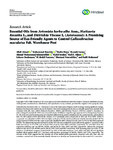Essential Oils from Artemisia herba alba Asso., Maticaria Recutita L., and Dittrichia Viscosa L. (Asteraceae): A Promising Source of Eco-Friendly Agents to Control Callosobruchus maculatus Fab. Warehouse Pest
| dc.contributor.author | Aimad, A | |
| dc.contributor.author | Bourhia, M | |
| dc.contributor.author | Hana, H | |
| dc.contributor.author | Sanae, R | |
| dc.contributor.author | Salamatullah, AM | |
| dc.contributor.author | Soufan, W | |
| dc.contributor.author | Rihan, Hail | |
| dc.contributor.author | Ouahmane, L | |
| dc.contributor.author | Youness, EA | |
| dc.contributor.author | Noureddine, E | |
| dc.contributor.author | Mohamed, F | |
| dc.date.accessioned | 2022-03-08T12:22:45Z | |
| dc.date.available | 2022-03-08T12:22:45Z | |
| dc.date.issued | 2022-01-30 | |
| dc.identifier.issn | 2090-9063 | |
| dc.identifier.issn | 2090-9071 | |
| dc.identifier.other | ARTN 2373460 | |
| dc.identifier.uri | http://hdl.handle.net/10026.1/18916 | |
| dc.description.abstract |
<jats:p>Callosobruchus maculatus (Fab.) (C. maculatus) is one of the major pests of legume seeds in storage causing significant damage, leading to food insecurity and low income for farmers. This work was planned to develop eco-friendly agents from essential oils of Artemisia herba alba Asso. (AEO), Maticaria Recutita L. (MEO), and Dittrichia Viscosa L. (DEO) to control C. maculatus. To achieve this goal, essential oils (EOs) were extracted by hydro-distillation using Clevenger apparatus before being characterized by GC-MS. EOs were used for testing purposes using three different tests, namely, inhalation toxicity, contact toxicity, and repellency tests. GC-MS analysis of EOs showed the presence of 16 potentially active compounds in AEO and 38 in MEO, whilst 15 compounds were identified in DEO. AEO was higher in thujone (57.6%) and chrysanthenone (11.8%). Santolina alcohol (40.7%) and germacrene D (8.9%) were the major compounds identified in MEO, whereas isocostic acid (72.3%) was the chief compound of DEO. The obtained findings showed that the studied EOs showed considerable insecticidal activity against C. maculatus with a lethal dose (LC50) of 3.78, 8.86, and 14.34 μL/1 liter of air by AEO, MEO, and DEO, respectively. At 1 μL/1 liter of air, the oviposition reduction rate was 90.02%, 70.65%, and 48.23% by AEO, MEO, and DEO, respectively, whereas the emergence reduction rate was 87.32%, 60.08%, and 32.24% by AEO, MEO, and DEO, respectively. With increasing doses up to 20 μL/L, the reduction of individual emergence reached 98.8% by AEO of 24 h after treatment. AEO, MEO, and DEO showed significant repellent effects against adults of C. maculatus with repulsion percentages of 60.83%, 50.83%, and 72.5%, respectively. The outcome of this work suggests that the essential oils of the studied plants, particularly Artemisia herba alba Asso. oils, can constitute a natural and environmentally friendly alternative to develop new bioinsecticides for the control of C. maculatus.</jats:p> | |
| dc.format.extent | 1-14 | |
| dc.language | en | |
| dc.language.iso | en | |
| dc.publisher | Hindawi Limited | |
| dc.title | Essential Oils from Artemisia herba alba Asso., Maticaria Recutita L., and Dittrichia Viscosa L. (Asteraceae): A Promising Source of Eco-Friendly Agents to Control Callosobruchus maculatus Fab. Warehouse Pest | |
| dc.type | journal-article | |
| dc.type | Journal Article | |
| plymouth.author-url | https://www.webofscience.com/api/gateway?GWVersion=2&SrcApp=PARTNER_APP&SrcAuth=LinksAMR&KeyUT=WOS:000766191700001&DestLinkType=FullRecord&DestApp=ALL_WOS&UsrCustomerID=11bb513d99f797142bcfeffcc58ea008 | |
| plymouth.volume | 2022 | |
| plymouth.publication-status | Published | |
| plymouth.journal | Journal of Chemistry | |
| dc.identifier.doi | 10.1155/2022/2373460 | |
| plymouth.organisational-group | /Plymouth | |
| plymouth.organisational-group | /Plymouth/Faculty of Science and Engineering | |
| plymouth.organisational-group | /Plymouth/Faculty of Science and Engineering/School of Biological and Marine Sciences | |
| plymouth.organisational-group | /Plymouth/Users by role | |
| plymouth.organisational-group | /Plymouth/Users by role/Academics | |
| dcterms.dateAccepted | 2022-01-13 | |
| dc.rights.embargodate | 2022-3-9 | |
| dc.identifier.eissn | 2090-9071 | |
| dc.rights.embargoperiod | Not known | |
| rioxxterms.versionofrecord | 10.1155/2022/2373460 | |
| rioxxterms.licenseref.uri | http://www.rioxx.net/licenses/all-rights-reserved | |
| rioxxterms.licenseref.startdate | 2022-01-30 | |
| rioxxterms.type | Journal Article/Review |


